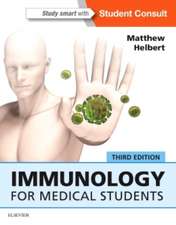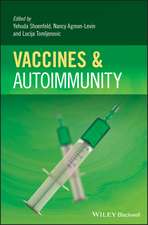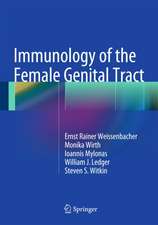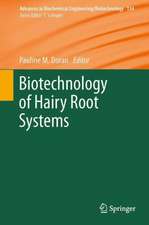Toxicology- From Cells to Man: Proceedings of the 1995 EUROTOX Congress Meeting Held in Prague, Czech Republic, August 27–l30, 1995: Archives of Toxicology, cartea 18
Editat de Jürg P. Seiler, Olga Kroftova, Vladislav Eyblen Limba Engleză Paperback – 22 sep 2011
Din seria Archives of Toxicology
- 5%
 Preț: 725.07 lei
Preț: 725.07 lei - 5%
 Preț: 376.06 lei
Preț: 376.06 lei - 5%
 Preț: 729.42 lei
Preț: 729.42 lei - 5%
 Preț: 382.43 lei
Preț: 382.43 lei - 5%
 Preț: 720.47 lei
Preț: 720.47 lei - 5%
 Preț: 1096.98 lei
Preț: 1096.98 lei - 15%
 Preț: 641.71 lei
Preț: 641.71 lei - 5%
 Preț: 731.43 lei
Preț: 731.43 lei - 5%
 Preț: 723.21 lei
Preț: 723.21 lei - 5%
 Preț: 733.66 lei
Preț: 733.66 lei - 5%
 Preț: 1105.21 lei
Preț: 1105.21 lei - 5%
 Preț: 721.19 lei
Preț: 721.19 lei - 5%
 Preț: 732.36 lei
Preț: 732.36 lei - 5%
 Preț: 725.07 lei
Preț: 725.07 lei - 5%
 Preț: 725.79 lei
Preț: 725.79 lei - 5%
 Preț: 738.41 lei
Preț: 738.41 lei - 5%
 Preț: 732.92 lei
Preț: 732.92 lei - 5%
 Preț: 730.71 lei
Preț: 730.71 lei
Preț: 724.50 lei
Preț vechi: 762.64 lei
-5% Nou
Puncte Express: 1087
Preț estimativ în valută:
138.64€ • 148.25$ • 115.59£
138.64€ • 148.25$ • 115.59£
Carte tipărită la comandă
Livrare economică 17 aprilie-01 mai
Preluare comenzi: 021 569.72.76
Specificații
ISBN-13: 9783642646966
ISBN-10: 3642646964
Pagini: 456
Ilustrații: IX, 441 p.
Dimensiuni: 155 x 235 x 24 mm
Greutate: 0.64 kg
Ediția:Softcover reprint of the original 1st ed. 1996
Editura: Springer Berlin, Heidelberg
Colecția Springer
Seria Archives of Toxicology
Locul publicării:Berlin, Heidelberg, Germany
ISBN-10: 3642646964
Pagini: 456
Ilustrații: IX, 441 p.
Dimensiuni: 155 x 235 x 24 mm
Greutate: 0.64 kg
Ediția:Softcover reprint of the original 1st ed. 1996
Editura: Springer Berlin, Heidelberg
Colecția Springer
Seria Archives of Toxicology
Locul publicării:Berlin, Heidelberg, Germany
Public țintă
ResearchCuprins
The Gerhard Zbinden Memorial Lecture.- Alteration of Cell Signalling in Chemical Toxicity.- Human Immunotoxicity and the Environment.- Halogenated Organic Compounds and the Human Immune System: Preliminary Report on a Study in Hobby Fishermen.- Risk Assessment for the Harmful Effects of UVB Radiation on the Immunological Resistance to Infectious Diseases.- Sentinel Screening for Human Immunotoxicity.- Impact of Environmental Pollution on Respiratory Sensitization and Asthma.- Functional Teratogenicity.- to Functional Teratology.- The Neurobehavioural Toxicology and Teratology of Lead.- Teratogenic Effects of Alcohol: Current Status of Animal Research and in vitro Models.- Developmental Neurotoxicology in the Neonate - Effects of Pesticides and Polychlorinated Organic Substances.- Drug Treatment in the Perinatal Period and the Risk of Functional Teratogenicity.- The Effects on Mammals of Pre- and Postnatal Environmental Exposure to PCBs: The Dutch Collaborative PCB/Dioxin Study.- Intercellular Communication.- Connexin Genes and Cell Growth Control.- Disruption of Polarized Function in Hepatocytes.- Cytokines in Human Lung Fibrosis.- The Glio-Vascular Toxicity of m-Dinitrobenzene and Related Agents: Modulation of Toxicity by Neuronal Activation.- Mechanistic Studies of the Inhibition of Intercellular Communication by Organochlorine Compounds.- Renal Toxicology.- Biotransformation and Renal Processing of Nephrotoxic Agents.- Methods for Studying Renal Toxicity.- Site Specific Drug and Xenobiotic Induced Renal Toxicity.- Metal Antidotes - New Developments.- Mobilizers of Stored Cadmium.- Chemical, Pharmacological, Toxicological and Therapeutic Advances of Deferiprone (LI) and Other Iron and Aluminium Chelators.- Free Radicals.- Free Radicals in Toxicology: Redox Cycling andNAD(P)H:Quinone Oxidoreductase.- Cytotoxic Impact of DNA Single vs Double Strand Breaks in Oxidatively Injured Cells.- Mineral Fiber-Induced Oxidative Stress in Phagocytes.- Toward Risk Assessment of Heterocyclic Amines in Food.- Chemical Methods for Assessing Systemic Exposure to Dietary Heterocyclic Amines in Man.- Immunological Methods for Dosimetry of Heterocyclic Amines.- Formation and Processing of Reactive Metabolites of the Heterocyclic Amines.- Enzymic and Interindividual Differences in the Human Metabolism of Heterocyclic Amines.- Extrapolation of Heterocyclic Amine Carcinogenesis Data from Rodents and Nonhuman Primates to Humans.- Clinical Toxicology of Peptides and Proteins.- Antibodies Proposed as Therapeutic Agents.- Unanticipated Human Toxicology of Recombinant Proteins.- The Mechanism of Action of Tetanus and Botulinum Neurotoxins.- Individual Susceptibility to Occupational Toxicants.- Specific Factors Leading to Interindividual Variability in Response to Occupational Toxicants.- Genetic Predisposition in Occupational Toxicology.- Individual Susceptibility to Occupational Toxicants: Practical Consequences for Risk Management.- Ecotoxicology in Central Europe.- Persistent Organic Pollutants - the State of Contamination of Ambient Air in Central Europe. Possible Sources and Effects.- Interdisciplinary “Case Studies” and Training Experts for Primary Prevention of Environmentally-Born Health Hazard.- Plants and Animals as Biomonitors of Heavy Metal Level in the Aquatic Ecosystem of the River Danube.- Ataxonomic Assessment of Phytoplankton Integrity by Means of Flow Cytometry.- The Young Scientist Poster Award.- Identification of the Highly Polymorphic S-Mephenytoin Hydroxylase in Humans.
Textul de pe ultima copertă
This volume contains the main papers presented at the 1995 EUROTOX Congress, Prague, Czech Republic, August 27 - 30, 1995. Cellular and subcellular models are used to improve our knowledge about mechanistic aspects of toxicological effects, and ultimately this deepened knowledge may serve to further improve our ability to cope with toxicological processes in man. This is reflected in symposia and workshops on intercellular communication, functional teratogenicity, risk assessment of heterocyclic amines in food, clinical toxicology of peptides and proteins, human immunotoxicity and individual susceptibility to occupational toxicants. Progresses in the fields of renal toxicology, metal antidotes and free radicals as well as increased awareness of ecotoxicological problems and effects in Central Europe are also discussed. A highlight of the Congress was certainly the first Gerhard Zbinden Memorial Lecture on alterations of cell signalling in chemical toxicity.












